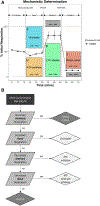Respirometric Screening and Characterization of Mitochondrial Toxicants Within the ToxCast Phase I and II Chemical Libraries
- PMID: 32374859
- PMCID: PMC10626520
- DOI: 10.1093/toxsci/kfaa059
Respirometric Screening and Characterization of Mitochondrial Toxicants Within the ToxCast Phase I and II Chemical Libraries
Abstract
Mitochondrial toxicity drives several adverse health outcomes. Current high-throughput screening assays for chemically induced mitochondrial toxicity typically measure changes to mitochondrial structure and may not detect known mitochondrial toxicants. We adapted a respirometric screening assay (RSA) measuring mitochondrial function to screen ToxCast chemicals in HepG2 cells using a tiered testing strategy. Of 1042 chemicals initially screened at a singlemaximal concentration, 243 actives were identified and rescreened at 7 concentrations. Concentration-response data for 3 respiration phases confirmed activity and indicated a mechanism for 193 mitochondrial toxicants: 149 electron transport chain inhibitors (ETCi), 15 uncouplers and 29 adenosine triphosphate synthase inhibitors. Subsequently, an electron flow assay was used to identify the target complex for 84 of the 149 ETCi. Sixty reference chemicals were used to compare the RSA to existing ToxCast and Tox21 mitochondrial toxicity assays. The RSA was most predictive (accuracy = 90%) of mitochondrial toxicity. The Tox21 mitochondrial membrane potential assay was also highly predictive (accuracy = 87%) of bioactivity but underestimated the potency of well-known ETCi and provided no mechanistic information. The tiered RSA approach accurately identifies and characterizes mitochondrial toxicants acting through diverse mechanisms and at a throughput sufficient to screen large chemical inventories. The electron flow assay provides additional confirmation and detailed mechanistic understanding for ETCi, the most common type of mitochondrial toxicants among ToxCast chemicals. The mitochondrial toxicity screening approach described herein may inform hazard assessment and the in vitro bioactive concentrations used to derive relevant doses for screening level chemical assessment using new approach methodologies.
Keywords: Seahorse; ToxCast; electron transport chain; high-throughput screening; mechanism; mitochondria; new approach methodologies; oxidative phosphorylation; respiration; uncoupling.
Published by Oxford University Press on behalf of the Society of Toxicology 2020. This work is written by US Government employees and is in the public domain in the US.
Conflict of interest statement
DECLARATION OF CONFLICTING INTERESTS
The authors declared no potential conflicts of interest with respect to the research, authorship, and/or publication of this article.
Figures







Similar articles
-
Assessment of ToxCast Phase II for Mitochondrial Liabilities Using a High-Throughput Respirometric Assay.Toxicol Sci. 2015 Aug;146(2):226-34. doi: 10.1093/toxsci/kfv085. Epub 2015 Apr 28. Toxicol Sci. 2015. PMID: 25926417 Free PMC article.
-
Comprehensive Analyses and Prioritization of Tox21 10K Chemicals Affecting Mitochondrial Function by in-Depth Mechanistic Studies.Environ Health Perspect. 2018 Jul 26;126(7):077010. doi: 10.1289/EHP2589. eCollection 2018 Jul. Environ Health Perspect. 2018. PMID: 30059008 Free PMC article.
-
High-throughput respirometric assay identifies predictive toxicophore of mitochondrial injury.Toxicol Appl Pharmacol. 2013 Oct 15;272(2):490-502. doi: 10.1016/j.taap.2013.06.014. Epub 2013 Jun 26. Toxicol Appl Pharmacol. 2013. PMID: 23811330 Free PMC article.
-
Application of ToxCast/Tox21 data for toxicity mechanism-based evaluation and prioritization of environmental chemicals: Perspective and limitations.Toxicol In Vitro. 2022 Oct;84:105451. doi: 10.1016/j.tiv.2022.105451. Epub 2022 Jul 31. Toxicol In Vitro. 2022. PMID: 35921976 Review.
-
The use of high-throughput screening techniques to evaluate mitochondrial toxicity.Toxicology. 2017 Nov 1;391:34-41. doi: 10.1016/j.tox.2017.07.020. Epub 2017 Aug 5. Toxicology. 2017. PMID: 28789971 Review.
Cited by
-
Predicting the Mitochondrial Toxicity of Small Molecules: Insights from Mechanistic Assays and Cell Painting Data.Chem Res Toxicol. 2023 Jul 17;36(7):1107-1120. doi: 10.1021/acs.chemrestox.3c00086. Epub 2023 Jul 6. Chem Res Toxicol. 2023. PMID: 37409673 Free PMC article.
-
Mild pentachlorophenol-mediated uncoupling of mitochondria depletes ATP but does not cause an oxidized redox state or dopaminergic neurodegeneration in Caenorhabditis elegans.Curr Res Toxicol. 2022 Aug 2;3:100084. doi: 10.1016/j.crtox.2022.100084. eCollection 2022. Curr Res Toxicol. 2022. PMID: 35957653 Free PMC article.
-
Inhibition of Neural Crest Cell Migration by Strobilurin Fungicides and Other Mitochondrial Toxicants.Cells. 2024 Dec 12;13(24):2057. doi: 10.3390/cells13242057. Cells. 2024. PMID: 39768149 Free PMC article.
-
Assessing Drug-Induced Mitochondrial Toxicity in Cardiomyocytes: Implications for Preclinical Cardiac Safety Evaluation.Pharmaceutics. 2022 Jun 21;14(7):1313. doi: 10.3390/pharmaceutics14071313. Pharmaceutics. 2022. PMID: 35890211 Free PMC article. Review.
-
Definition of the Neurotoxicity-Associated Metabolic Signature Triggered by Berberine and Other Respiratory Chain Inhibitors.Antioxidants (Basel). 2023 Dec 28;13(1):49. doi: 10.3390/antiox13010049. Antioxidants (Basel). 2023. PMID: 38247474 Free PMC article.
References
-
- Alonso JR, Cardellach F, López S, Casademont J, and Miró O. (2003). Carbon monoxide specifically inhibits cytochrome c oxidase of human mitochondrial respiratory chain. Pharmacol. Toxicol 93, 142–146. - PubMed
-
- Attene-Ramos MS, Huang R, Michael S, Witt KL, Richard A, Tice RR, Simeonov A, Austin CP, and Xia M. (2015). Profiling of the Tox21 chemical collection for mitochondrial function to identify compounds that acutely decrease mitochondrial membrane potential. Environ. Health Perspect 123, 49–56. - PMC - PubMed
-
- Balba H. (2007). Review of strobilurin fungicide chemicals. J. Environ. Sci. Health B 42, 441–451. - PubMed
Publication types
MeSH terms
Substances
Grants and funding
LinkOut - more resources
Full Text Sources

